人教版(2019)选择性必修 第二册Unit 5 First Aid Learning About Language课件(共58张PPT)
文档属性
| 名称 | 人教版(2019)选择性必修 第二册Unit 5 First Aid Learning About Language课件(共58张PPT) |  | |
| 格式 | pptx | ||
| 文件大小 | 6.1MB | ||
| 资源类型 | 教案 | ||
| 版本资源 | 人教版(2019) | ||
| 科目 | 英语 | ||
| 更新时间 | 2023-12-28 11:30:23 | ||
图片预览

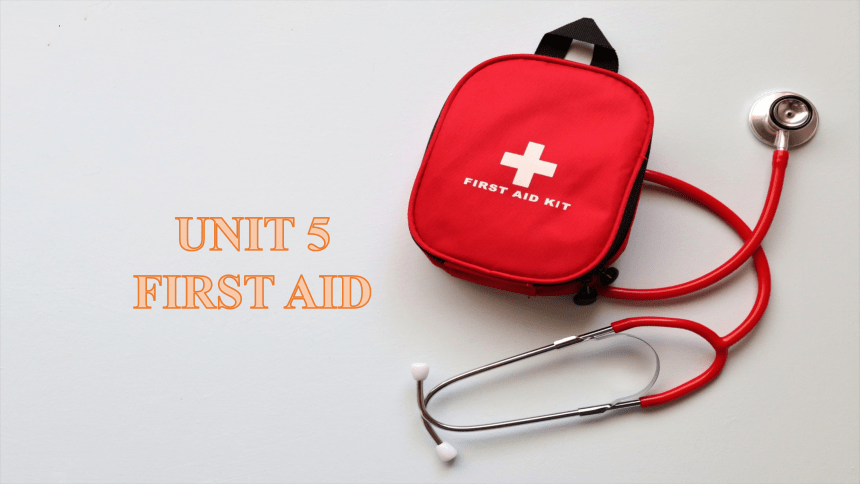

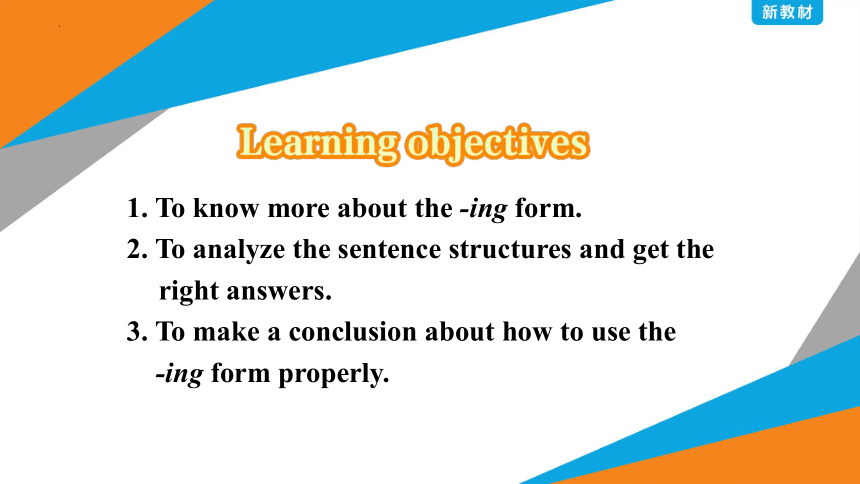
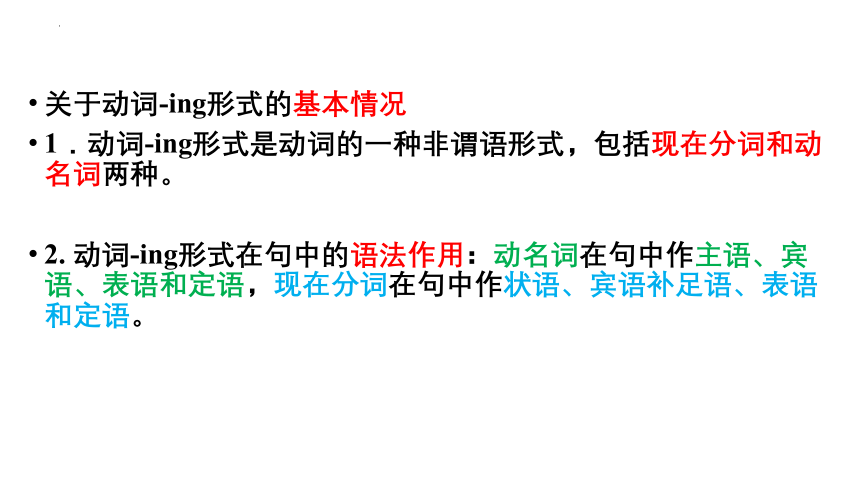
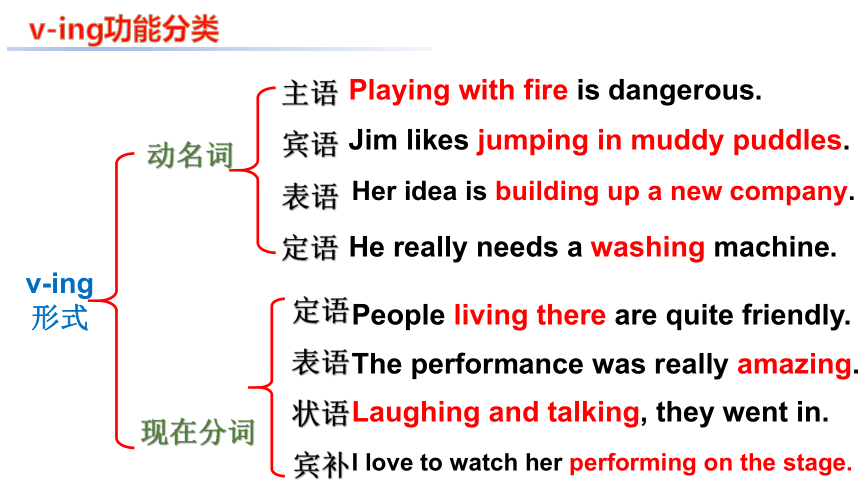
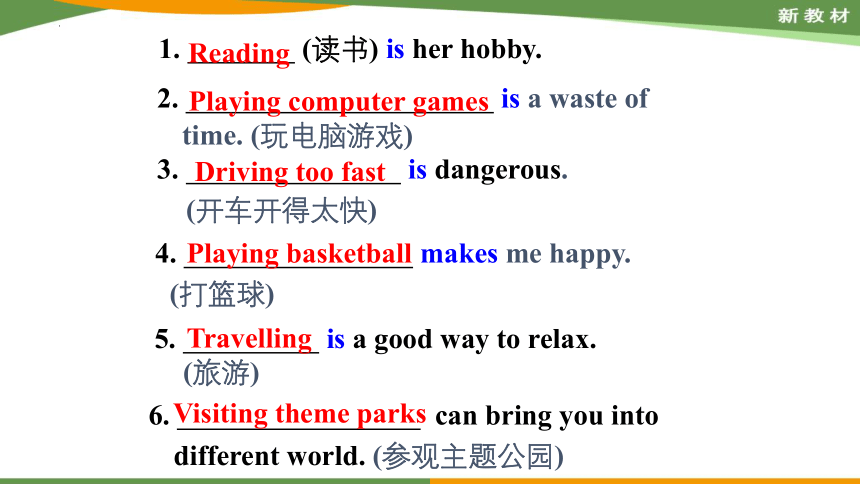
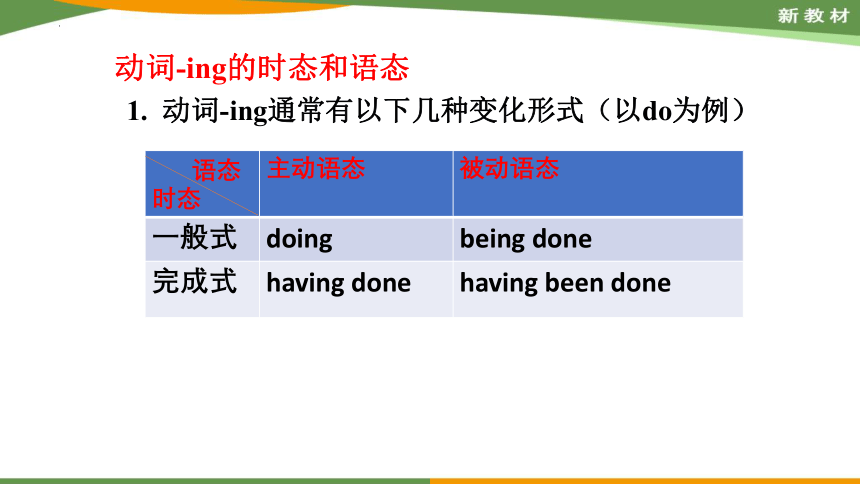

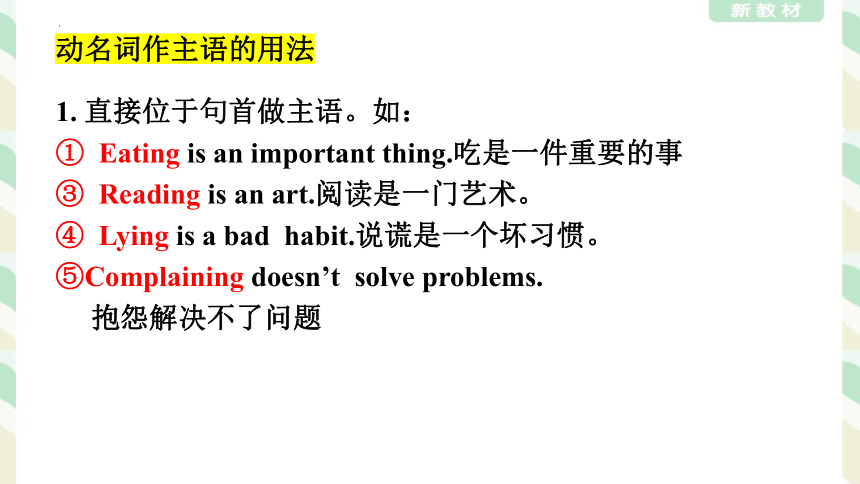

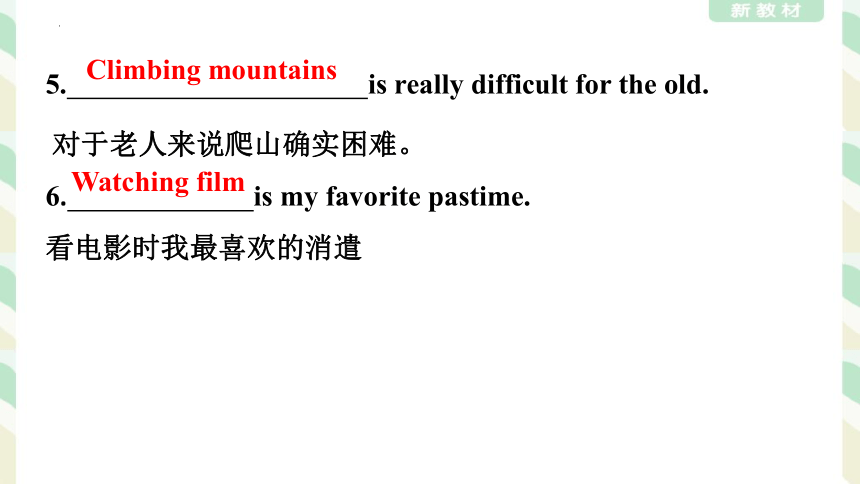
文档简介
(共58张PPT)
Unit 5
UNIT 5
FIRST AID
1. To know more about the -ing form.
2. To analyze the sentence structures and get the right answers.
3. To make a conclusion about how to use the
-ing form properly.
关于动词 ing形式的基本情况
1.动词 ing形式是动词的一种非谓语形式,包括现在分词和动名词两种。
2. 动词 ing形式在句中的语法作用:动名词在句中作主语、宾语、表语和定语,现在分词在句中作状语、宾语补足语、表语和定语。
v-ing功能分类
v-ing形式
动名词
现在分词
主语
宾语
表语
定语
定语
表语
状语
宾补
Playing with fire is dangerous.
Jim likes jumping in muddy puddles.
Her idea is building up a new company.
People living there are quite friendly.
He really needs a washing machine.
The performance was really amazing.
Laughing and talking, they went in.
I love to watch her performing on the stage.
1. (读书) is her hobby.
Reading
2. is a waste of time. (玩电脑游戏)
Playing computer games
3. is dangerous.
(开车开得太快)
Driving too fast
4. makes me happy.
(打篮球)
Playing basketball
5. is a good way to relax.
(旅游)
Travelling
6. can bring you into different world. (参观主题公园)
Visiting theme parks
动词-ing的时态和语态
1. 动词-ing通常有以下几种变化形式(以do为例)
语态时态 主动语态 被动语态
一般式 doing being done
完成式 having done having been done
动名词作主语的用法
动名词作主语往往表示经常性、 习惯性或抽象的动作或道理。
动名词常常被看作是不可数名词,作主语的时候,谓语动词用单数
动名词作主语的用法
1. 直接位于句首做主语。如:
Eating is an important thing.吃是一件重要的事
Reading is an art.阅读是一门艺术。
Lying is a bad habit.说谎是一个坏习惯。
⑤Complaining doesn’t solve problems.
抱怨解决不了问题
1. is her hobby.
阅读是他的爱好。
2. new words is very important for me.
学习新单词对我来说非常重要。
3. is easier than doing.
说比做容易。
Practice time
Reading
Learning
Speaking
5. is really difficult for the old.
对于老人来说爬山确实困难。
6. is my favorite pastime.
看电影时我最喜欢的消遣
Climbing mountains
Watching film
用it做形式主语,真正的主语是动名词。常用-ing形式作主语的句型有:
It + is/was +a waste of time doing…
做……是浪费时间的
It is/was no good/use doing…
做……是没益/用处的
It is/was no useless doing…
做……是没有用的
It is/was worth/worthwhile doing …
做……是值得的
It is/was hardly/scarcely worth doing …
做……不值得
用it做形式主语,真正的主语是动名词。常用-ing形式作主语的句型有:
It is/was no fun doing…
做……没有乐趣
There is/was no sense in doing…
做……没有道理
1.It is no use (wait)for him any longer.
2. It is useless _______(try) to explain.
3. It is a waste of time and money _______ (see) that movie.
4. There is no good / use (in) _______ (argue) with him.
waiting
trying
seeing
arguing
一、动词 ing形式作宾语
宾语的概念
宾语是动作、行为的对象,是动作承受者。
宾语由名词、代词、不定式或相当于名词的词,短语来担任。
常跟动词ing作宾语的动词歌诀:
考虑建议盼原谅,
承认推迟没得想,
避免错过继续练,
否认完成停能赏,
不禁介意准逃亡,
不准冒险凭想象。
consider, suggest / advise, look forward to, pardon
admit, delay / put off, fancy
avoid, miss, keep / keep on, practise
deny, finish, stop, enjoy / appreciate
can’t help, mind, allow/ permit, escape
forbid, risk, imagine
My mother advised ________(ask) a doctor to come and examine my eyes.
我的妈妈建议叫一个医生来检查我的眼睛。
You can’t avoid _________(make) a mistake.
你不可能避免犯错误。
asking
making
Would you mind (open) the window
你介意我开窗户吗?
I really enjoy (do)the promotion this time
我真的享受现时所做的宣传。
opening
doing
页码 20
动词-ing形式作介词的宾语。注意: insist on, object to, lead to, put off, give up, be/get used to, look forward to, feel like, pay attention to, stick to, devote to等中的to都是介词而不是动词不定式符号。
I’m looking forward to_________(receive) your letter.
receiving
第 21 页
有些动词后既可跟动词-ing形式作宾语, 也可跟动词不定式作宾语。
动词-ing To do
Like, love, hate prefer 泛指的动作 具体的一次性动作
Begin, start, continue 意义无区别
Forget,remember, regret 已经发生的动作 将要发生的动作
以下及物动词后既可接不定式又可接v. ing作宾语,但两者意义上有区别。
(1)remember to do sth记得要去做某事(没有做)
remember doing sth记得做过某事 (已经做了)
I remember to meet her at the station.
我记得要去车站接她。
I remember turning off the light .
我记得我关了灯。
(2)forget to do sth忘记要去做某事( 没有做)
forget doing sth忘记做过某事(已经做过)
I forgot to tell you about it. Now here it is.
我忘记告诉你这件事了,是这样的。
I forgot giving it to you yesterday.
我忘记昨天已经把它给你了。
(3) regret to do sth 很遗憾/抱歉地去做某事 (将要做)
regret doing sth 后悔做了某事(已经做了)
we regret to inform you that your application has not been successful.
我们很遗憾的通知您,您的申请没有通过。
I regret not working hard
我后悔没有努力学习。
主要是to tell, to say, to inform等,此时句子主语一般是第一人称。
(4)can't help to do sth 不能帮着去做某事
can't help doing sth 禁不住做某事
I can't help to clean the house with so much work to do.
我有太多工作要做,不能帮着收拾屋子。
She can't help laughing at the thought of the joke he told her.
一想到他讲的笑话,她禁不住大笑。
go on to do 接着做另一件事
go on doing 继续做同一件事
stop to do 停下来(做别的事)
stop doing 停止做某事
其他。对比分析:
try to do 努力做某事
try doing 试着做某事
used to do sth 过去常常做某事
be used to doing sth 习惯做某事
mean to do 打算做某事
mean doing 意味着做某事
He stopped ________ (smoke) and have a rest.
He really must stop_________ (smoke).
3)—The light in the office is still on.
—Oh,I forgot ______________(turn) it off.
4)The light in the office is off, but she forgets_________ (turn) it off.
5)Would you mind ________(move) the box for me
6)We are all looking forward to _____ (visit) the museum soon.
to smoke
smoking
to turn
to learn
Practice time
turning
moving
visiting
7) I can’t help ________ (clean) the room, for I am too busy.
8) After hearing the joke, we can’t help _________ (laugh).
9) Though it rained, they went on _________ (work).
10) We have finished Part 1. Let’s go on _________ (learn) Part 2.
to clean
laughing
working
to learn
页码 30
即:need/require/want/deserve doing =need/require/want/deserve to be done
For example:
These clothes need washing.=
These clothes need _____________________.
The requires _________________.
=The houhouse se requires to be repaired.
在动词need, require, want, deserve后,用动词-ing形式表示被动含义
to be washed
repairing
V-ing形式做表语
V-ing形式做表语,意为“令人…..的”。此时的v-ing的功能相当于形容词,说明人或物所具备的特征。
The music is very interesting to the ear.
这段音乐非常的悦耳。
This dog is frightening.
这条狗令人害怕。
Her job is teaching.
Teaching is her job.
His task is _____________ (answer) the phone.
Tom' s duty is ____________(clean) the classroom.
answering
cleaning
作表语的动名词体现的是名词的特征,用于对主语的内容进行解释说明,往往表示主语所具有的特征,且主语和表语可以互换。
作表语的现在分词(短语)是形容词性的,表示主语的性质或特征,主语和表语不可互换。
His concern for children is touching.
The problem is quite puzzling.
具备形容词性的 V-ing 有:amazing, amusing, annoying, astonishing, boring, charming...
如:His words are quite encouraging.
V+ed 形式做表语表示主语所处的状态或主语的感受,常被译为“感到…..的”
The boy’s exam results were disappointing . His parents felt disappointed.
V-ing 主语一般是物
V-ed 主语一般是人
当被修饰的名词时face,smile, look, voice 等能表现出人的感情的名词时,通常用-ed等形式的形容词
A worried look 焦虑的神色
An excited voice激动的声音
It is believed that if a book is _________ (interest), it will surely interest the reader.
2.The situation both at home and abroad is very
(inspire鼓舞)
3.The news was __________ (shock), and there was a __________ (frighten) look on her face.
interesting
shocking
frightened
inspiring
-ing作定语的意义
动名词作定语
a sleeping car
动名词作定语表示被修饰词的某种________或________,不表示名词本身的动作, 相当于for引导的介词短语。
=
功能
用途
a car for sleeping
动名词作定语
a pool for swimming
a __________pool
=
swimming
a __________room
=
a room for reading
reading
-ing作定语的意义
现在分词作定语
a sleeping boy
现在分词作定语,表示被修饰词的_______或__________。现在分词与被修饰的词为_______关系,或___________。
=
状态
a boy who is sleeping
动作
主动
正在进行
-ing作定语的位置
1.单个的现在分词作定语时,通常位于它所修饰的名词或代词_____。
前面
a flying bird
boiling water
a burning house
-ing作定语的位置
注意:单个的现在分词修饰复合不定代词something, everything, anything, nothing等,要放在这些词的_______。
后面
I have something interesting to say.
2. Anything amazing is welcomed here.
a sleeping dog
一只睡觉的狗
Translation
一棵正在倒下的树
a falling tree
Translation
a swimming pig
a dancing girl
一个跳舞的女孩
一个游泳的小猪
(1) 现在分词作定语时,放在所修饰的名词之后,表示所修饰词进行的一个动作,相当于一个定语从句。
The man standing there is Peter’s father.
= The man who is standing there is Peter’s father.
站在那个地方的那个人时皮特的父亲。
The boy playing football on the playground is my younger brother
=The boy who is playing football on the playground is my younger brother
注意:现在分词(Ving)、过去分词(Ved)和 不定式(to do )
区别
现在分词(Ving)表示正在进行或主动
现在分词(Ved)表示已完成或者被动
不定式(to do )表示动作尚未发生或目的
The ground is covered with fallen leaves.地上满是落叶
I’m looking for a room to live in .我正在找房子住
V-ing形式作宾语补足语
1) 动 词 –ing 形 式 作 宾 语 补 足 语 常 放 在 宾语 后 面 ,表 示
一个 正 在 进 行 的 主 动 性 的 动 作,或存在的状态。
When we returned to the school, we found a stranger
standing at the entrance.
I found a bird singing in the tree.
能用-ing形式作宾语补足语的几类动词:
A. 表示感觉和心理状态的动词, 常见的有see(看), hear, (听见) feel, (感觉)smell(闻), find(发现), notice(注意), observe(注意到), look at(看), listen to(听)等+sb+ doing sth(作宾补)
I saw him walking in the street.
我看见他在街上走。
I heard them singing in the classroom.
我听见他们在教室里唱歌。
We found the boy sleeping. 我们发现小孩睡着了。
能用-ing形式作宾语补足语的几类动词:
B. 表示“使,令,让,帮,叫”等意义的动词(使役动词), 常见的有 make, have, let, set, keep, get, leave等+sb /sth+doing sth (宾补)
I won’t have you doing that.
This set me thinking.
I’m sorry to have kept you waiting.
We kept the fire burning all the night long .
C.作介词 with 的宾补,在 “with+ 宾语 +doing” 结
构中,doing 表示主动或进行。
With the final exam approaching,the students are studying harder.
【注】
“with+ 宾语 +done”表示被动或完成;
“with+ 宾语 +to do”表示尚未发生。
He lay in bed with his eyes focused on the ceiling.
他躺在床上,眼睛盯着天花板。
With an interview to take,he felt a little nervous.
要参加面试,他感到有点儿紧张。
(1)We shouldn’t keep him (continue)to waste his time playing games.
(2) When I came in,I saw Linda (comfort) the crying girl.
(3) He was just about to sit down when he felt something ___________ (move)near his feet.
(4) The living room is clean and tidy,with a Christmas tree _________(stand)in the middle.
Practice time
continuing
comforting
moving
standing
动词-ing形式作状语
动词-ing形式作状语时,可以表示时间、原因、结果、条件、让步、方式、伴随情况等,其前可加连词while, when,(当) once,(曾经) if(如果),unless (除非)等。
1.作时间状语(相当于一个时间状语从句)
Walking in the park ,she saw an old friend .
当她在公园散步时,她看到了她的一个老朋友。
注意:表示正在进行的动作时,可直接在分词前加上when /while,此时也可理解为状语从句的省略
2.作原因状语(一般可转换成由as 或because引导的原因状语从句)
Being ill,he couldn’t go to school.
因为生病了,他无法去上学。
3.作条件状语(一般放在句首,可转换成由if, unless等连词引导的条件状语从句)
Working hard ,you’ll make great progress.
如果你努力工作,你将取得很大进步。
4.作结果状语(现在分词作状语时,常放在句末,表示一种顺其自然、意料之中得结果。)
The hospital has recently obtained new medical equipment, allowing more patients to be treated .
这家医院最近新得到一批新的医疗设备,这使更多的病人能得到治疗。
5.作让步、方式和伴随状语(现在分词作让步、方式、和伴随状语时,说明动作发生的背景和情况。作伴随状语时,表示分词的动作和主句的动作同时发生,此时它可转换成并列句。)
Mary sat by the window of the classroom , reading a book
=Mary sat by the window of the classroom and was reading a book
当现在分词的动作先发生,而谓语动词的动作后发生时,用分词的完成式
Having finished the letter , he went to post it.
他写完信后就把它寄出去了。
Not knowing this ,he didn’t come.
他不知道这件事,所以没来。
Practice time
1.__________ (walk)the street one day, she met an old friend of hers.
(Turn)to the right ,you’ll find the children’s ward there.
3.While (wait) for the bus, he read a copy of China Daily.
Walking
Turning
waiting
Unit 5
UNIT 5
FIRST AID
1. To know more about the -ing form.
2. To analyze the sentence structures and get the right answers.
3. To make a conclusion about how to use the
-ing form properly.
关于动词 ing形式的基本情况
1.动词 ing形式是动词的一种非谓语形式,包括现在分词和动名词两种。
2. 动词 ing形式在句中的语法作用:动名词在句中作主语、宾语、表语和定语,现在分词在句中作状语、宾语补足语、表语和定语。
v-ing功能分类
v-ing形式
动名词
现在分词
主语
宾语
表语
定语
定语
表语
状语
宾补
Playing with fire is dangerous.
Jim likes jumping in muddy puddles.
Her idea is building up a new company.
People living there are quite friendly.
He really needs a washing machine.
The performance was really amazing.
Laughing and talking, they went in.
I love to watch her performing on the stage.
1. (读书) is her hobby.
Reading
2. is a waste of time. (玩电脑游戏)
Playing computer games
3. is dangerous.
(开车开得太快)
Driving too fast
4. makes me happy.
(打篮球)
Playing basketball
5. is a good way to relax.
(旅游)
Travelling
6. can bring you into different world. (参观主题公园)
Visiting theme parks
动词-ing的时态和语态
1. 动词-ing通常有以下几种变化形式(以do为例)
语态时态 主动语态 被动语态
一般式 doing being done
完成式 having done having been done
动名词作主语的用法
动名词作主语往往表示经常性、 习惯性或抽象的动作或道理。
动名词常常被看作是不可数名词,作主语的时候,谓语动词用单数
动名词作主语的用法
1. 直接位于句首做主语。如:
Eating is an important thing.吃是一件重要的事
Reading is an art.阅读是一门艺术。
Lying is a bad habit.说谎是一个坏习惯。
⑤Complaining doesn’t solve problems.
抱怨解决不了问题
1. is her hobby.
阅读是他的爱好。
2. new words is very important for me.
学习新单词对我来说非常重要。
3. is easier than doing.
说比做容易。
Practice time
Reading
Learning
Speaking
5. is really difficult for the old.
对于老人来说爬山确实困难。
6. is my favorite pastime.
看电影时我最喜欢的消遣
Climbing mountains
Watching film
用it做形式主语,真正的主语是动名词。常用-ing形式作主语的句型有:
It + is/was +a waste of time doing…
做……是浪费时间的
It is/was no good/use doing…
做……是没益/用处的
It is/was no useless doing…
做……是没有用的
It is/was worth/worthwhile doing …
做……是值得的
It is/was hardly/scarcely worth doing …
做……不值得
用it做形式主语,真正的主语是动名词。常用-ing形式作主语的句型有:
It is/was no fun doing…
做……没有乐趣
There is/was no sense in doing…
做……没有道理
1.It is no use (wait)for him any longer.
2. It is useless _______(try) to explain.
3. It is a waste of time and money _______ (see) that movie.
4. There is no good / use (in) _______ (argue) with him.
waiting
trying
seeing
arguing
一、动词 ing形式作宾语
宾语的概念
宾语是动作、行为的对象,是动作承受者。
宾语由名词、代词、不定式或相当于名词的词,短语来担任。
常跟动词ing作宾语的动词歌诀:
考虑建议盼原谅,
承认推迟没得想,
避免错过继续练,
否认完成停能赏,
不禁介意准逃亡,
不准冒险凭想象。
consider, suggest / advise, look forward to, pardon
admit, delay / put off, fancy
avoid, miss, keep / keep on, practise
deny, finish, stop, enjoy / appreciate
can’t help, mind, allow/ permit, escape
forbid, risk, imagine
My mother advised ________(ask) a doctor to come and examine my eyes.
我的妈妈建议叫一个医生来检查我的眼睛。
You can’t avoid _________(make) a mistake.
你不可能避免犯错误。
asking
making
Would you mind (open) the window
你介意我开窗户吗?
I really enjoy (do)the promotion this time
我真的享受现时所做的宣传。
opening
doing
页码 20
动词-ing形式作介词的宾语。注意: insist on, object to, lead to, put off, give up, be/get used to, look forward to, feel like, pay attention to, stick to, devote to等中的to都是介词而不是动词不定式符号。
I’m looking forward to_________(receive) your letter.
receiving
第 21 页
有些动词后既可跟动词-ing形式作宾语, 也可跟动词不定式作宾语。
动词-ing To do
Like, love, hate prefer 泛指的动作 具体的一次性动作
Begin, start, continue 意义无区别
Forget,remember, regret 已经发生的动作 将要发生的动作
以下及物动词后既可接不定式又可接v. ing作宾语,但两者意义上有区别。
(1)remember to do sth记得要去做某事(没有做)
remember doing sth记得做过某事 (已经做了)
I remember to meet her at the station.
我记得要去车站接她。
I remember turning off the light .
我记得我关了灯。
(2)forget to do sth忘记要去做某事( 没有做)
forget doing sth忘记做过某事(已经做过)
I forgot to tell you about it. Now here it is.
我忘记告诉你这件事了,是这样的。
I forgot giving it to you yesterday.
我忘记昨天已经把它给你了。
(3) regret to do sth 很遗憾/抱歉地去做某事 (将要做)
regret doing sth 后悔做了某事(已经做了)
we regret to inform you that your application has not been successful.
我们很遗憾的通知您,您的申请没有通过。
I regret not working hard
我后悔没有努力学习。
主要是to tell, to say, to inform等,此时句子主语一般是第一人称。
(4)can't help to do sth 不能帮着去做某事
can't help doing sth 禁不住做某事
I can't help to clean the house with so much work to do.
我有太多工作要做,不能帮着收拾屋子。
She can't help laughing at the thought of the joke he told her.
一想到他讲的笑话,她禁不住大笑。
go on to do 接着做另一件事
go on doing 继续做同一件事
stop to do 停下来(做别的事)
stop doing 停止做某事
其他。对比分析:
try to do 努力做某事
try doing 试着做某事
used to do sth 过去常常做某事
be used to doing sth 习惯做某事
mean to do 打算做某事
mean doing 意味着做某事
He stopped ________ (smoke) and have a rest.
He really must stop_________ (smoke).
3)—The light in the office is still on.
—Oh,I forgot ______________(turn) it off.
4)The light in the office is off, but she forgets_________ (turn) it off.
5)Would you mind ________(move) the box for me
6)We are all looking forward to _____ (visit) the museum soon.
to smoke
smoking
to turn
to learn
Practice time
turning
moving
visiting
7) I can’t help ________ (clean) the room, for I am too busy.
8) After hearing the joke, we can’t help _________ (laugh).
9) Though it rained, they went on _________ (work).
10) We have finished Part 1. Let’s go on _________ (learn) Part 2.
to clean
laughing
working
to learn
页码 30
即:need/require/want/deserve doing =need/require/want/deserve to be done
For example:
These clothes need washing.=
These clothes need _____________________.
The requires _________________.
=The houhouse se requires to be repaired.
在动词need, require, want, deserve后,用动词-ing形式表示被动含义
to be washed
repairing
V-ing形式做表语
V-ing形式做表语,意为“令人…..的”。此时的v-ing的功能相当于形容词,说明人或物所具备的特征。
The music is very interesting to the ear.
这段音乐非常的悦耳。
This dog is frightening.
这条狗令人害怕。
Her job is teaching.
Teaching is her job.
His task is _____________ (answer) the phone.
Tom' s duty is ____________(clean) the classroom.
answering
cleaning
作表语的动名词体现的是名词的特征,用于对主语的内容进行解释说明,往往表示主语所具有的特征,且主语和表语可以互换。
作表语的现在分词(短语)是形容词性的,表示主语的性质或特征,主语和表语不可互换。
His concern for children is touching.
The problem is quite puzzling.
具备形容词性的 V-ing 有:amazing, amusing, annoying, astonishing, boring, charming...
如:His words are quite encouraging.
V+ed 形式做表语表示主语所处的状态或主语的感受,常被译为“感到…..的”
The boy’s exam results were disappointing . His parents felt disappointed.
V-ing 主语一般是物
V-ed 主语一般是人
当被修饰的名词时face,smile, look, voice 等能表现出人的感情的名词时,通常用-ed等形式的形容词
A worried look 焦虑的神色
An excited voice激动的声音
It is believed that if a book is _________ (interest), it will surely interest the reader.
2.The situation both at home and abroad is very
(inspire鼓舞)
3.The news was __________ (shock), and there was a __________ (frighten) look on her face.
interesting
shocking
frightened
inspiring
-ing作定语的意义
动名词作定语
a sleeping car
动名词作定语表示被修饰词的某种________或________,不表示名词本身的动作, 相当于for引导的介词短语。
=
功能
用途
a car for sleeping
动名词作定语
a pool for swimming
a __________pool
=
swimming
a __________room
=
a room for reading
reading
-ing作定语的意义
现在分词作定语
a sleeping boy
现在分词作定语,表示被修饰词的_______或__________。现在分词与被修饰的词为_______关系,或___________。
=
状态
a boy who is sleeping
动作
主动
正在进行
-ing作定语的位置
1.单个的现在分词作定语时,通常位于它所修饰的名词或代词_____。
前面
a flying bird
boiling water
a burning house
-ing作定语的位置
注意:单个的现在分词修饰复合不定代词something, everything, anything, nothing等,要放在这些词的_______。
后面
I have something interesting to say.
2. Anything amazing is welcomed here.
a sleeping dog
一只睡觉的狗
Translation
一棵正在倒下的树
a falling tree
Translation
a swimming pig
a dancing girl
一个跳舞的女孩
一个游泳的小猪
(1) 现在分词作定语时,放在所修饰的名词之后,表示所修饰词进行的一个动作,相当于一个定语从句。
The man standing there is Peter’s father.
= The man who is standing there is Peter’s father.
站在那个地方的那个人时皮特的父亲。
The boy playing football on the playground is my younger brother
=The boy who is playing football on the playground is my younger brother
注意:现在分词(Ving)、过去分词(Ved)和 不定式(to do )
区别
现在分词(Ving)表示正在进行或主动
现在分词(Ved)表示已完成或者被动
不定式(to do )表示动作尚未发生或目的
The ground is covered with fallen leaves.地上满是落叶
I’m looking for a room to live in .我正在找房子住
V-ing形式作宾语补足语
1) 动 词 –ing 形 式 作 宾 语 补 足 语 常 放 在 宾语 后 面 ,表 示
一个 正 在 进 行 的 主 动 性 的 动 作,或存在的状态。
When we returned to the school, we found a stranger
standing at the entrance.
I found a bird singing in the tree.
能用-ing形式作宾语补足语的几类动词:
A. 表示感觉和心理状态的动词, 常见的有see(看), hear, (听见) feel, (感觉)smell(闻), find(发现), notice(注意), observe(注意到), look at(看), listen to(听)等+sb+ doing sth(作宾补)
I saw him walking in the street.
我看见他在街上走。
I heard them singing in the classroom.
我听见他们在教室里唱歌。
We found the boy sleeping. 我们发现小孩睡着了。
能用-ing形式作宾语补足语的几类动词:
B. 表示“使,令,让,帮,叫”等意义的动词(使役动词), 常见的有 make, have, let, set, keep, get, leave等+sb /sth+doing sth (宾补)
I won’t have you doing that.
This set me thinking.
I’m sorry to have kept you waiting.
We kept the fire burning all the night long .
C.作介词 with 的宾补,在 “with+ 宾语 +doing” 结
构中,doing 表示主动或进行。
With the final exam approaching,the students are studying harder.
【注】
“with+ 宾语 +done”表示被动或完成;
“with+ 宾语 +to do”表示尚未发生。
He lay in bed with his eyes focused on the ceiling.
他躺在床上,眼睛盯着天花板。
With an interview to take,he felt a little nervous.
要参加面试,他感到有点儿紧张。
(1)We shouldn’t keep him (continue)to waste his time playing games.
(2) When I came in,I saw Linda (comfort) the crying girl.
(3) He was just about to sit down when he felt something ___________ (move)near his feet.
(4) The living room is clean and tidy,with a Christmas tree _________(stand)in the middle.
Practice time
continuing
comforting
moving
standing
动词-ing形式作状语
动词-ing形式作状语时,可以表示时间、原因、结果、条件、让步、方式、伴随情况等,其前可加连词while, when,(当) once,(曾经) if(如果),unless (除非)等。
1.作时间状语(相当于一个时间状语从句)
Walking in the park ,she saw an old friend .
当她在公园散步时,她看到了她的一个老朋友。
注意:表示正在进行的动作时,可直接在分词前加上when /while,此时也可理解为状语从句的省略
2.作原因状语(一般可转换成由as 或because引导的原因状语从句)
Being ill,he couldn’t go to school.
因为生病了,他无法去上学。
3.作条件状语(一般放在句首,可转换成由if, unless等连词引导的条件状语从句)
Working hard ,you’ll make great progress.
如果你努力工作,你将取得很大进步。
4.作结果状语(现在分词作状语时,常放在句末,表示一种顺其自然、意料之中得结果。)
The hospital has recently obtained new medical equipment, allowing more patients to be treated .
这家医院最近新得到一批新的医疗设备,这使更多的病人能得到治疗。
5.作让步、方式和伴随状语(现在分词作让步、方式、和伴随状语时,说明动作发生的背景和情况。作伴随状语时,表示分词的动作和主句的动作同时发生,此时它可转换成并列句。)
Mary sat by the window of the classroom , reading a book
=Mary sat by the window of the classroom and was reading a book
当现在分词的动作先发生,而谓语动词的动作后发生时,用分词的完成式
Having finished the letter , he went to post it.
他写完信后就把它寄出去了。
Not knowing this ,he didn’t come.
他不知道这件事,所以没来。
Practice time
1.__________ (walk)the street one day, she met an old friend of hers.
(Turn)to the right ,you’ll find the children’s ward there.
3.While (wait) for the bus, he read a copy of China Daily.
Walking
Turning
waiting
